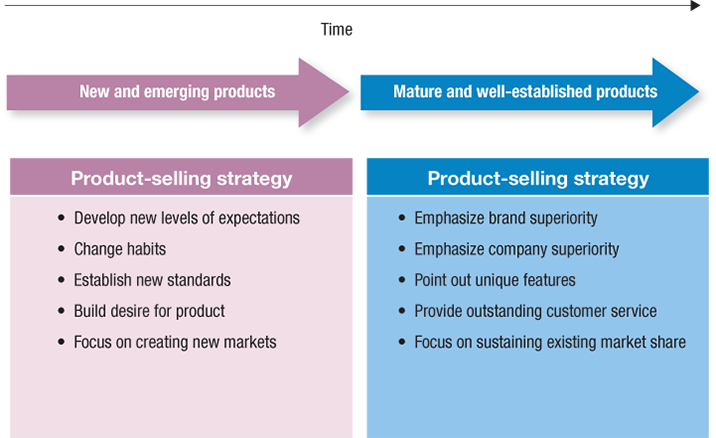Product-Positioning Strategies to Sell New (vs. Mature), and Low-Priced (vs. Value-Added) Products
7.3 Discuss product-positioning options
Product positioning is a concept that applies to both new and existing products. Given the dynamics of most markets, it may be necessary to reposition products several times in their lives because even solid, popular products can lose market position quickly. Salespeople have assumed an important and expanding role in differentiating products. To succeed in our over-communicated society, marketers must use a direct and personalized form of communication with customers. Advertising directed toward a mass market often fails to position a complex product.
Throughout the remainder of this chapter, we discuss specific ways to use various product-positioning strategies to differentiate your value proposition. We explain how salespeople can (1) position new and emerging products versus well-established products, (2) position products with price strategies, and (3) position products with value-added strategies.
Selling New Products Versus Well-Established Products
In many ways, products are like human beings. They are born, grow up, mature, and grow old. In marketing, this process is known as the product life cycle. The product life cycle includes the stages a product goes through from the time it is first introduced to the market until it is discontinued. As the product moves through its cycle, the strategies relating to competition, promotion, pricing, and other factors must be evaluated and possibly changed. The nature and extent of each stage in the product life cycle are determined by several factors, including the following:
The product’s perceived advantage over available substitutes
The product’s benefits and the importance of the needs it fulfills
Competitive activity, including pricing, substitute product development and improvement, and effectiveness of competing advertising and promotion
Changes in technology, fashion, or demographics14
As we attempt to develop a product-selling strategy, we must consider where the product is positioned in terms of the life cycle. The sales strategy used to sell a new and emerging product is much different from the strategy used to sell a mature, well-established product (Figure 7.2).

Figure 7.2 New Versus Mature Product-Selling Model
Product-selling strategies are significantly different for selling new versus mature products. Selling new products requires successfully providing new insights to add value, while selling mature products requires positioning product and company superiority over competition.
Selling New and Emerging Products
Selling strategies used during the new and emerging stage (see Figure 7.2) are designed to develop a new level of expectation, change habits, and, in some cases, establish a new standard of quality.15 The goal is to build desire for the product. Highly talented and resourceful salespeople are needed during the product initiation phase.16 Salespeople must be resourceful, possess information regarding every aspect of the product, and be able to present a convincing value proposition.17
When Brother International Corporation introduced its line of Multi-Function Center (MFC) machines, the goal was to convince buyers that one machine could replace five separate machines. However, before buyers would give up their copy machine, fax machine, laser printer, and other machines, they asked some hard questions. Is a multifunction machine reliable? Does the quality match that of the current machines? Finding the best machine for each customer is challenging because Brother offers more than 10 different MFC models from which to choose.
In some cases, the new product is not a tangible item. Several years ago, IntraLinks closed its first big sale, a $50,000 contract, with J.P. Morgan. The company got its start providing the financial services industry with the secure transmission of highly confidential information across the Internet. Patrick Wack and his business partners convinced J.P. Morgan and other financial firms that they did not need to rely on an army of foot messengers and FedEx trucks to deliver sensitive documents. They were not only selling a new product; they were selling a vision that included new levels of expectations. The value proposition focused on faster, more secure document transfer, which, in the customer’s mind, translated into improved customer service and cost savings. Today Patrick Wack is selling this document transfer concept to customers in a variety of business communities.18
Selling Mature and Well-Established Products
Mature and well-established products are usually characterized by intense competition as new brands enter the market. Customers who currently buy your product will become aware of competing products. With new and emerging products, salespeople may initially have little or no competition and may dominate the market; however, this condition may not last long.
New York Life Insurance Company provides its sales agents with new products almost every year. The product portfolio was recently expanded to include the Asset Preserver, which allows the policy death benefit to be accelerated, on an income tax–free basis, to pay for long-term care services. The company also developed the Universal Life Protector, which offers long-term protection at lower prices. New products offered by a market leader are quickly copied by competing insurance companies. When competing products enter the market, New York Life agents must adopt new strategies. One positioning strategy is to emphasize the company’s 150 years of outstanding service to policyholders. They can also note that New York Life is a “mutual” company; it is owned by policyholders, not corporate shareholders. The objective is to create in the customer’s mind the perception that New York Life is a solid company that will be strong and solvent when it’s time to pay premiums.19
The relationship strategy is often critical in selling mature and well-established products. To maintain market share and ward off competitors, many salespeople work hard to maintain a strong relationship with the customer. At New York Life, salespeople have found that good service after the sale is one of the best selling strategies because it builds customer loyalty.
